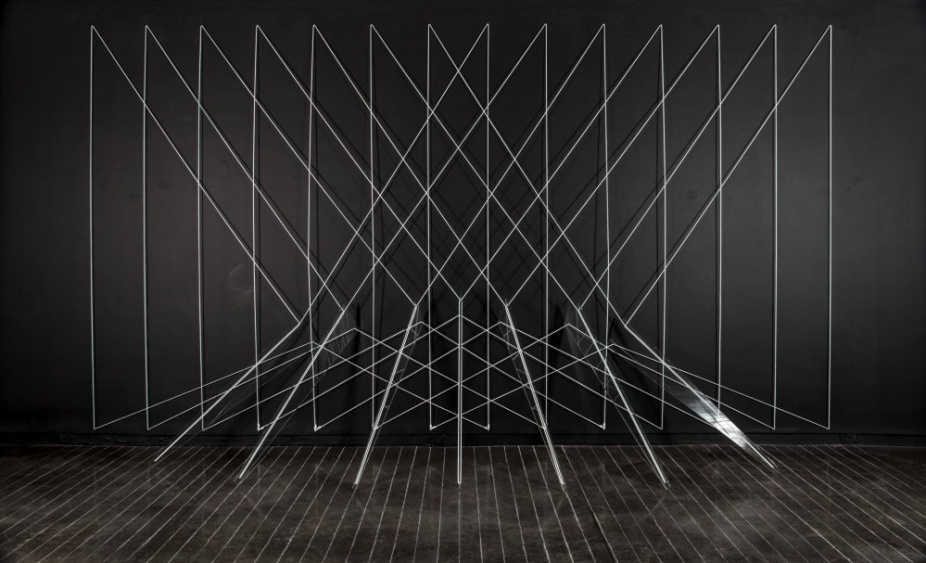Lydia Okumura: Situations

Lydia Okumura, In Front of Light, 1977/2015. Glass, string, and nails, dimensions variable. Courtesy of the artist and Broadway 1602 Gallery.
Lydia Okumura (b. 1948, Brazil) actively challenges viewers to question their perception of space through sculptures, installations and works on paper that blur the line between two and three dimensions. Beginning as a young artist in São Paulo, she studied the Japanese art magazine Bijutsu Techou that introduced her to international movements such as Conceptual Art, Minimalism, Land Art, and Arte Povera. These movements, along with Brazilian Concretism and Neo-Concretism, influenced Okumura’s work. Utilizing simple materials such as string, glass, and paint, her work dynamically balances line, plane, and shadow. Working for almost 50 years, she continues to explore the realms of geometric abstraction through both re-imaginations of past installations and new work.
While Okumura’s work is reminiscent of fellow Latin American artists such as Lygia Pape and Carmen Herrera as well as contemporaries such as Dorothea Rockburne and Robert Irwin, she has remained under-recognized in her field. Although the São Paolo Biennial is one of the longest-running international biennials, the current focus on Latin American artists is more recent. A native of São Paolo, Okumura has exhibited widely in the city and is part of multiple museum collections, but she is much less known in her adopted country of the United States. Lydia Okumura: Situations is the artist’s first solo museum exhibition in the United States. Through the exhibition and catalog, the UB Art Galleries seeks to encourage critical reassessment of Okumura’s entire oeuvre and secure her position as a dynamic and integral figure in art history.
About the Artist: Lydia Okumura was born in São Paulo in 1948 to a Japanese immigrant family. She attended a Japanese school in Brazil — merging two very distinct cultural influences that continue to resonate in her work. Her father Takashi, a prominent calligrapher, awakened and encouraged Okumura’s interest in art. She specialized in industrial ceramics and painting, which she displayed at her first solo exhibition at Varanda Galeria in 1968. From 1970-1973, she attended Fundação Armando Alvares Penteado and received her Bachelor of Fine Arts.
In 1970, Okumura began working in a collective based in São Paulo named Equipe3 with artists Genilson Soares and Francisco Inarra. With their installation in the 1973 International Biennial of São Paulo titled Pontos de vista (Viewpoints), Okumura developed her signature style of extended geometrical compositions in site-specific spaces. Upon receiving a four-year scholarship to the Pratt Graphics Center in 1974, she moved to New York City. In the following years, Okumura exhibited some of her most prominent paintings and installations in various galleries, institutions, and collectors’ homes in New York City and São Paulo.
Okumura first traveled to Japan in 1979 as a resident artist at Wako University and subsequently has had numerous exhibitions in Japan, including in Today’s Art of Brazil, in 1985—an exhibition at the Hara Museum of Contemporary Art in Tokyo, Japan, where Okumura’s work was acquired for the Museum’s permanent collection. The previous year, Okumura had a solo exhibition at the São Paulo Museum of Modern Art. Beginning in 1989, Okumura started working in the Public Services Department at the United Nations, while simultaneously producing art at her studio in Union Square, New York. Her work is included in numerous collections, including The Metropolitan Museum of Art, NY; The Hara Museum of Contemporary Art, Japan; Museo de Art Moderna, Brazil; The Akron Art Museum, Ohio; and Museum of Belas Artes, Venezuela.
This exhibition is supported by Broadway 1602 Gallery and Buffalo Wire Works.